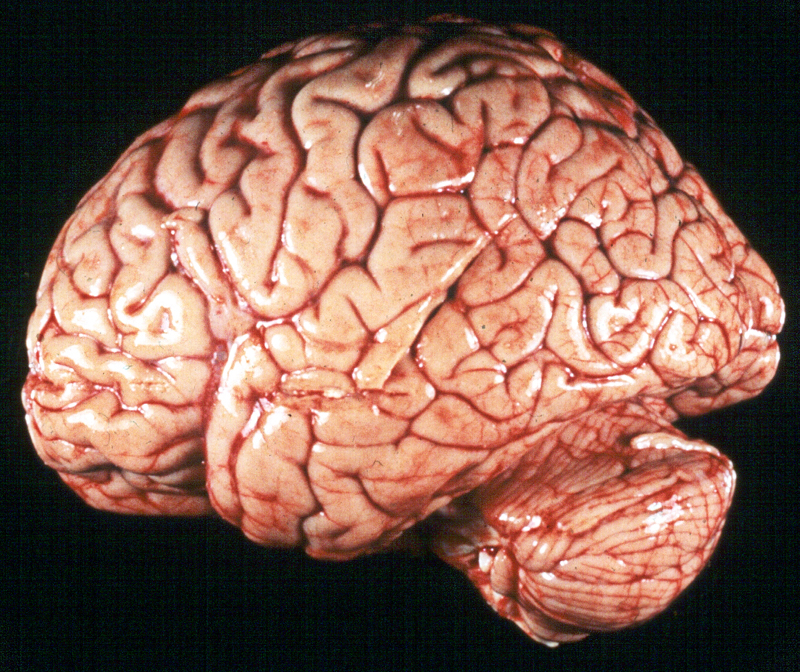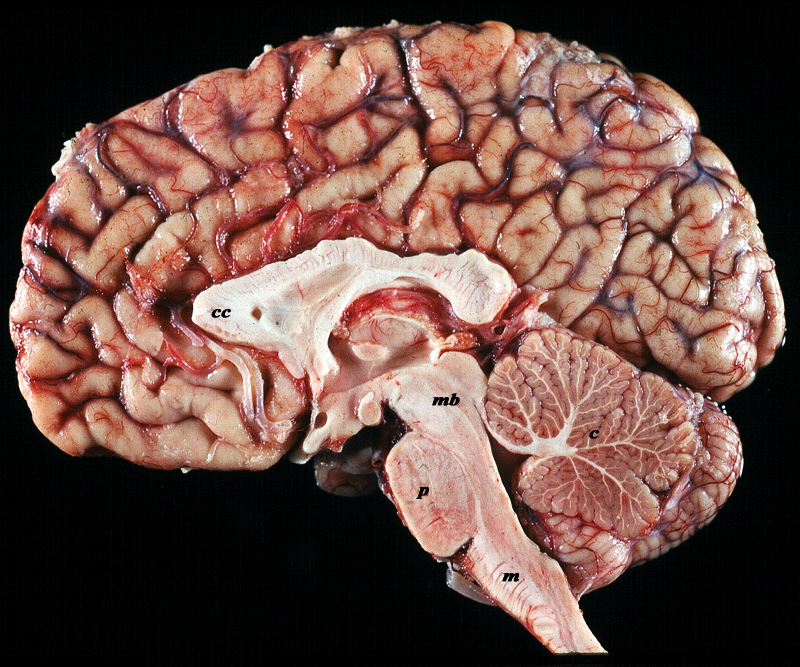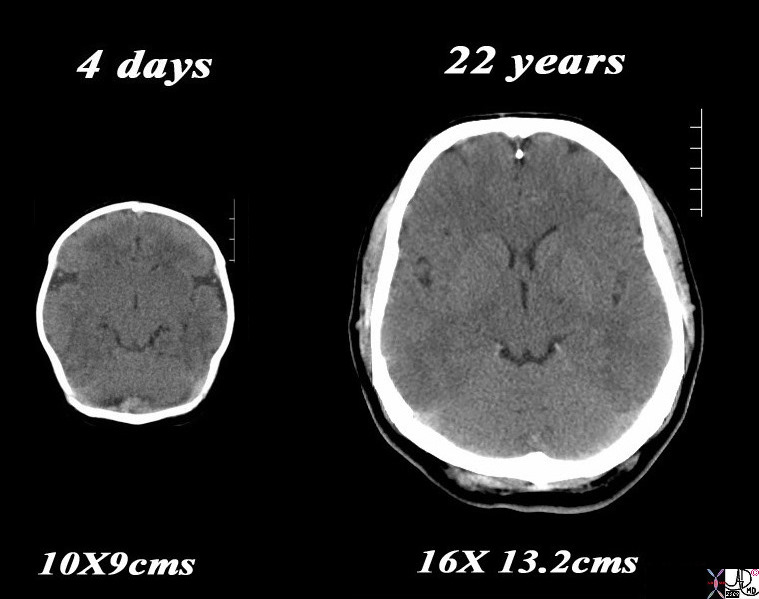Size of the Brain
Copyright 2010
Introduction
The brain is one of the largest organs in the body and it weighs approximately 1300 to 1400 grams (2.8 to 3.1 pounds). The brain attains its maximum size by 18 years of life. In males it weighs about weighs 1360 grams (3 pounds), and in adult females it weighs 1250 grams (2.8 pounds). The brain’s weight begins to decline at the age of 50-55.
Linear dimensions are approximately 17 cm in longitudinal size, 14 cm in transverse and 13 cm in height, in the adult male. In the adult female, each of these dimensions is about 1 cm less in each dimension.
The brain occupies a volume of around 1200 mL, being about 1260mls for men and 1130 for women. and is constituted by about 100 billion neurons.
It represents about 2% body weight but receives >20% of blood supply. . It contains approximately 12,000,000,000 nerve cells.
The brain density is 1.030 g/dm3
The cerebral cortex is the outer layer of the brain and is also called the gray matter. It is thrown into a series of folds called gyri and almost 2/3 of the gray mater is buried in the depths of the gyri. The folding in of the gyri enables the amount of cortex to be considerably larger than the space afforded to the brain by the cranium so that the surface area of the cortex is 2,500 cm2.
This trick of nature is also played by the mucosal folds, villi and crypts of the gastrointestinal tract and in similar but not exactly the same manner , by the alveoli of the lung which bulge outward to increase their surface area by creating a spheres.
41% of the cerebral cortex is found in the frontal lobes, while 22% is in the temporal lobe, 19% in the parietal lobe (19%) and 18% in the occipital lobe. (Kennedy)
The volume of the CSF is about 140mls which is close to 10% ogf the intracranial volume. The SG of CSF is 1.008kg/m3.
The thicknes of the cranial bone is between 4-7mms consisting of an outer layer of compact bone (1-2mms) middle layer of thick spongy bone (diploe) that measures 2-4mms) and an inner layer of compact bone (1-2mms). (Yoganandan)
Gray and White Matter Sulci and Gyri
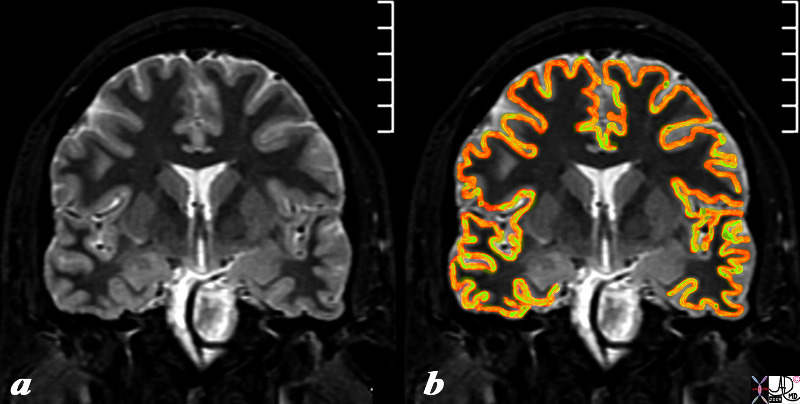
The Folds of the Brain Enabling an Increase in the Surface Area |
|
The coronal view is from a T2 weighted MRI of a 27year old male showing the manner in which the forebrain increases its surface area and therefore functional capabilities by a series of folds called gyri across the entire surface of the brain. The cortex and gray matter is overlaid in luminescent yellow orange, and is the site of functionality. The white CSF is seen on the surface of the brain and folds in with the gyri remaining on the surface of the cortex on the brain Courtesy Ashley Davidoff MD copyright 2010 all rights reserved 89734c04.8s |
The larger the brain of a particular species the larger the cortex. The thickness of the cortex ranges between 1.5-4.5 mm.
Ratio of the volume of grey matter to white matter in the cerebral hemipheres (20 yrs. old) = 1.3 (Miller) , while at 50 years = 1.1 and by 100 years= 1.5 (Miller et al., 1980) suggesting preferential loss of gray matter at around 50 years and then preferential loss of white matter subsequently.
% of cerebral oxygen consumption by white matter = 6%
% of cerebral oxygen consumption by gray matter = 94%
The right cerebral hemishere tends to be slightly larger than the left but the cerebellar hemisphers are more equal in size.
The volume of CSF in the brain is about 150ccs which is equal to the amount of blood in the brain.
Proportionally, the human brain seems to be larger in comparison to other animals, however, the higher intellectual functions that humans posses are likely the result of more complex neuronal connections than they are the result of the size of the organ.
Relative Sizes of the Parts of the Brain
|
Relative size on External View of the Midbrain and Hindbrain External View |
|
The relative size of the forebrain compared to the hindbrain is also well demonstrated The brain has a characteristic appearance manifest by its creamy color, characteristic shape and fissured surface. To the feel it is said to feel like soft butter. The anatomic specimen reveals an external view of the brain. The characteristic cream color of the brain can be appreciated on this specimen. This reflects the color of the gray matter and external portion of the cortex The surface of the hemispheres is known as cortex. It presents as a system of irregular prominences (called convolutions or gyri) that circumscribe depressions (called fissures or sulci) which are somewhat profound and full of twists and turns. This morphology enables the brain to increase its functioning surface area significantly The sulci and gyri of the forebrain are distinctly different from the pattern of the cerebellum. Courtesy of Thomas W.Smith, MD; Department of Pathology, University of Massachusetts Medical School. 97804 |
|
Relative Size of the Components of the Forebrain Midbrain and Hind Brain Midsagittal View |
|
The relative sizes of the forebrain, midbrain and hindbrain are well appreciated in this section. The midsagittal section view of brain reveals the distinction between the character of the cerebral cortex which has a creamy color and the white matter exemplified by the corpus callosum (cc white), and the midbrain (mb), pons (p) and medulla (m) which are off white in color as opposed to the color of the cerebellum (c) which is light salmon pink in color. Image Courtesy of Thomas W.Smith, MD; Department of Pathology, University of Massachusetts Medical School. 97805b01 |
Difference in the Sexes
There seems to a difference in some of the parts of the brain between the sexes. females tend to have a higher volume of cortex while males tend to have a higher volume of white matter and CSF. (Cosgrove)
Differences in Age
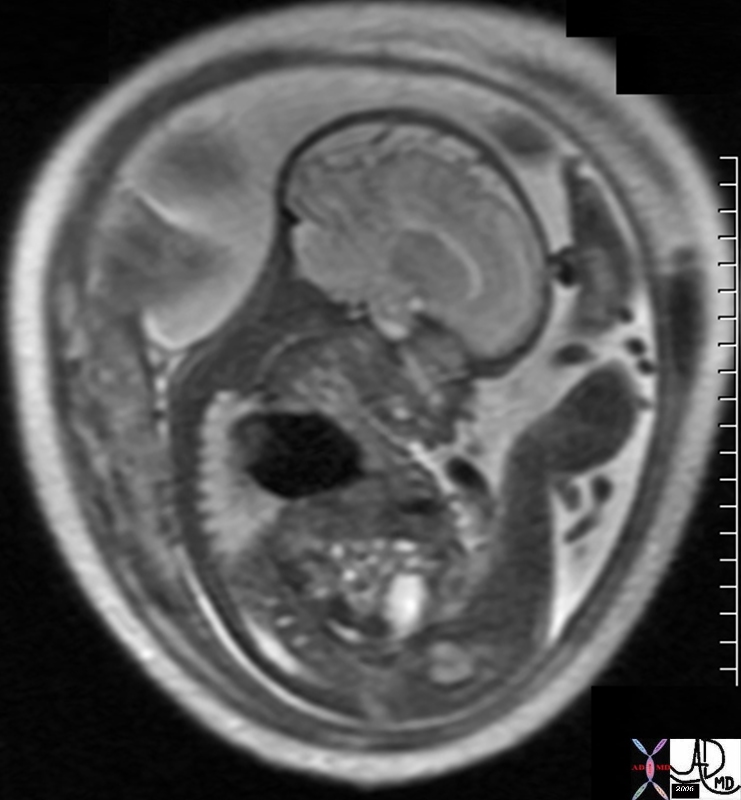
MRI of a Fetus showing the brain in Sagittal Section |
|
Courtesy Ashley Davidoff MD copyright 2010 46081 |
At birth it is estimated that the human brain weighs approximately 400g. During the first few years of life, the brain increases in size to about 3 times its birth weight as a result of myelination, and the growth of neuronal processes. The brain continues to grow but at a slower rate, up until the age of 18.
|
The Neonatal Brain and the Adult Brain |
|
The axial images of the brain at the level of the colliculi show the brain as depicted by a CTscan from a 4day old neonate, and a CTscan from a 22 year old adult. The brain reaches its adult size at about 18 years. Courtesy Ashley Davidoff MD copyright 2010 90347c06.91s |
The size of the brain as measured by the biparietal diameter is a measure of the fetal age
At 12 weeks the biparietal diameter (BPD) is about 21mms while head circumference (HC) is 70mms. By 25 weeks the BPD is 64mms and the HC about 232mms, and by term at 42 weeks the BPD is 100mms, and the head circumference is 351mms.
The brain attains its maximum size by 18 years of life. In males it weighs about weighs 1360 grams (3 pounds), and in adult females it weighs 1250 grams (2.8 pounds).

Size and Maturation Changes With Time The Prophet Ezekiel |
| The heads of a young boy, a youth and adulthood are beautifully depicted by Michelangelo in his rendition of the prophet Ezekiel in the Sistine Chapel. The young boy to the right seems to express fear, the older boy purity compliance and physical agility while Ezekiel shows commitment and a forcefulness of his mission.
The Prophet Ezekiel Sistine Chapel Michelangelo 13230 |
Brain in Disease Applied Biology
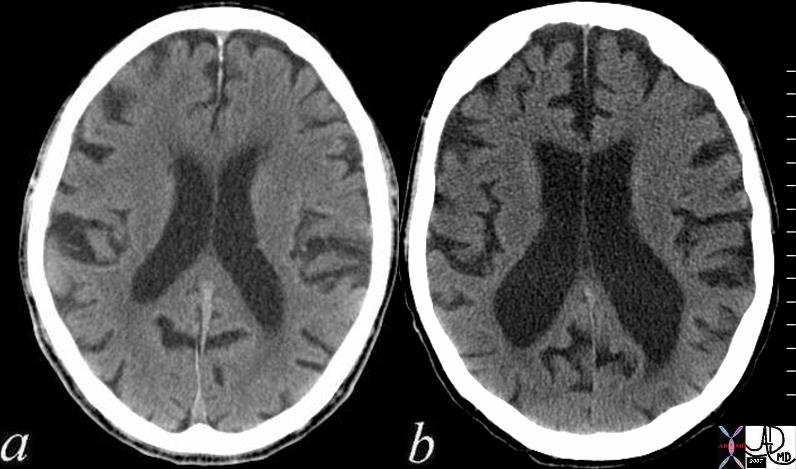
70 year Brain in Two Different Patients “Normal” Involution (a) Normal Pressure Hydrocephalus (b) |
|
The 2 CT scans show 70 year old brains in two different patients. The patient on the left (a), reveals normal involution of the brain characterized by deepening of the sulci and prominence of the gyri together with a prominent ventricular system. Contrast this brain with the CT scan of the 22 year old above where the sulci and gyri are barely distinguished and the ventricles are slit like. The second patient (b) has a condition called normal pressure hydrocephalus (NPH). In addition to having “normal” involution, the patient also has dilated ventricles more than one would expect for the degree of involution. This is an abnormal finding. Courtesy Ashley Davidoff MD Copyright 2010 72179c01 |
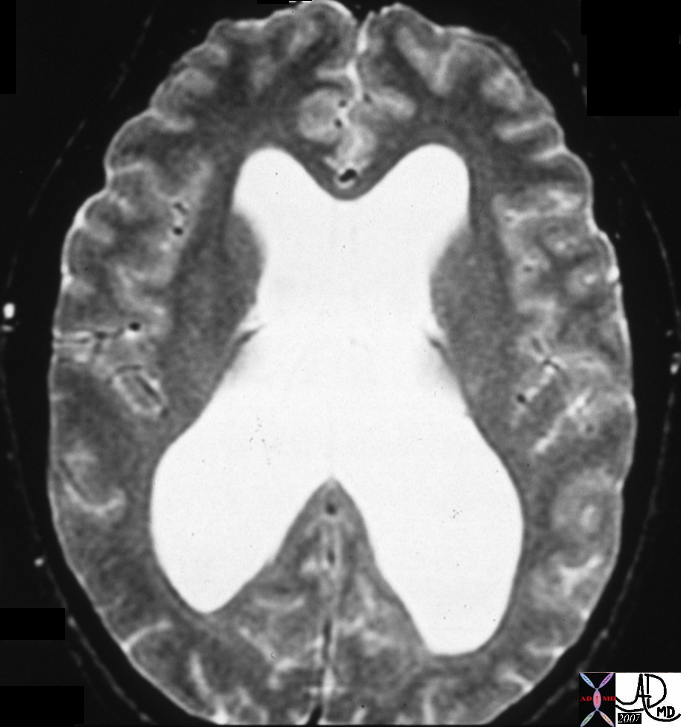
Hydrocephalus – Ventricles that are too Large- Aqueductal Stenosis |
|
The T2 weighted MRI image in the axial plane shows very enlarged ventricles (white butterf;y structures) caused by a condition called aqueductal steniois which prevents flow of the CSF through the aqueduct of Sylvius and results in a build up of pressure Image Courtesy James Donnelly MD 21644 |
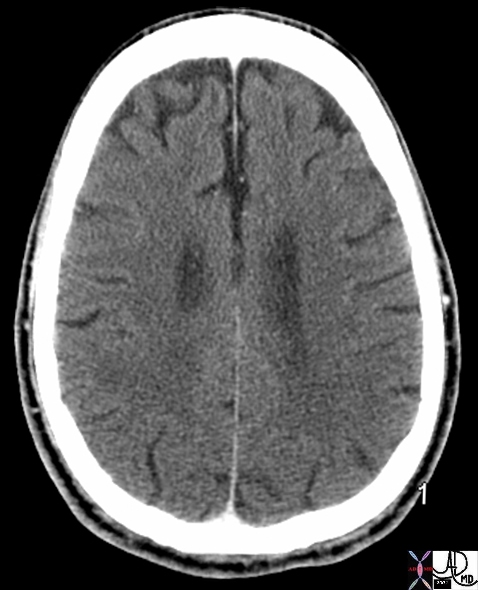
Small Frontal Lobes |
| The axial CT of the brain of a 50 year old male shows mild bifrontal atrophy as revealed by an increase in the extra-axial space
Courtesy Ashley Davidoff MD Copyright 2010 72736.600 |
Size of the Brain in the Animal Kingdom and in Evolution
Brain size in general is reflective of sophistication of behaviour. Primates therefore have relatively large brains, placental animals larger brains than their marsupial counterparts, and predators tend to have larger brains than their prey. There is a ratio called the brain to body weight ratio (aka encephalization quotient or EQ) that is a rough estimate of intelligence. The human for example has an EQ of 7.44, the chimpanzee 2.48, the elephant 1.87, whale 1.76, dog1.17, cat 1.00, mouse .50, and the rat and rabbit .40
As the brain increases in size, the cortex is the part that enlarges the most.
As homo spaiens has evolved brain size has increased and body size decreased.
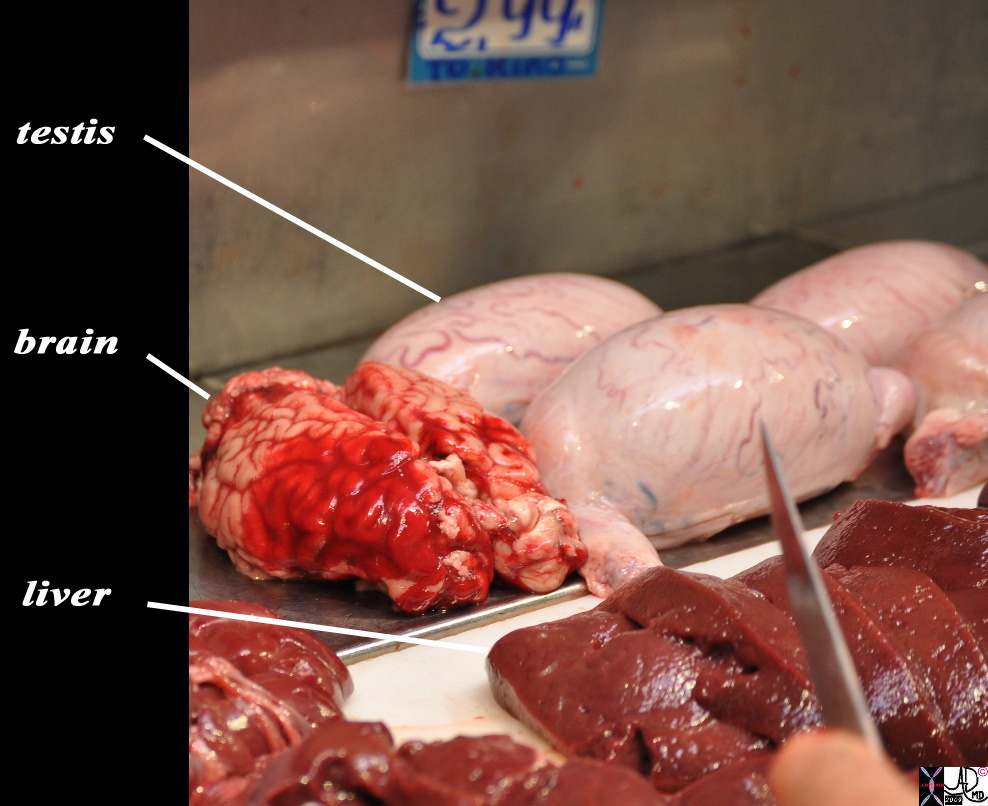
Meat Market of Athens Brain Testes, and Liver |
|
At the meat market in Athens the brain of a cow was dsiplayed alongside the testes of a bull. Researching the wights of these organs it appeared that single testis was almost the size of the brain An average adult scrotal circumference is 30cms and the weight of a pair of bulls testes can be up to 700grams while the weight of a cows brain is between 450-500 grams. Courtesy Ashley Davidoff MD copyright 2010 96257pb.82s |
The average weight of a pair of testes in Holstein bulls is about 700grams (Coulter)
The brain weights of some well known people:
The brain of Albert Einstein weighed 1230 grams (2.71 pounds)
The brain of the German mathematician Carl Friedrich Gauss weighed 1492 grams (3.29 pounds)
The brain of the leading poet of Russian Revolution Vladimir Vladimirovich Mayakovsky weighed 1700 grams (3.75 pounds)”
References
Kennedy DN., MAkris N, Bates J, Meyer J, Caviness Jr VS
Gyri of the human neocortex: an MRI-based analysis of volume and variance. Cerebral Cortex, Vol 8, 372-384, Copyright © 1998 by Oxford University Press
Miller, A.K., Alston, R.L. and Corsellis, J.A., Variation with age in the volumes of grey and white matter in the cerebral hemispheres of man: measurements with an image analyser, Neuropathol Appl Neurobiol., 6:119-132, 1980
Washington.edu Brain Facts and Figures
Cosgrove, KP; Mazure CM, Staley JK (2007). “Evolving knowledge of sex differences in brain structure, function, and chemistry.”. Biol Psychiat 62 (8): 847–55.
Yoganandan, Narayan Pintar, F, Larson S, Sances, A Frontiers in head and neck trauma: clinical and biomechanical IOS Press Amsterdam 1998

